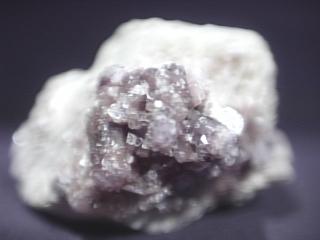
LEPIDOLITE
Specimen lep-2
$ 65.00
Dims: 2.6" x 2.5" x 1.8"(6.6 x 6.4 x 4.6 cm)
Wt: 6.57 oz.(186.3 g)
Itinqa, Brazil
The Lepidolite crystals on this specimen occur in the form of small "books" that are quite long for their diameter, looking more like prismatic crystals with basal faces. These books, though somewhat warped, have definite and discernable trigonal and hexagonal cross-sections. They range in size from a few millimeters in length and diameter to as much as 0.7"(1.8 cm) long and 0.3"(0.8 cm) in diameter. They all show a pale violet-pink coloration and are translucent, with a pearly luster on their basal cleavage planes and a dull luster on their "prism" faces. There are at least 20 of these books concentrated in a small area on an albite base rock. Several thin, transparent crystals of pink-violet tourmaline are grown into the Lepidolite cluster. None of these crystals exceeds 0.5"(1.3 cm) in length. The albite base shows definite crystal form and considerable damage. We've had a difficult time finding Lepidolite books with a definite hexagonal shape.
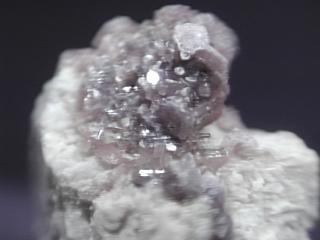
 Amethyst Galleries' Mineral Gallery MINERALS |
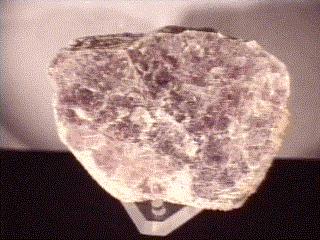
LEPIDOLITE specimen lep-1
$ 30.00
$ 30.00
Dims: 5.75" x 4.50" x 1"
Wt: 1.50lb
Minas Gerais, Brazil
I would've loved to see the pegmatite that this monster came out of! It is one huge book of Lepidolite, a pink variety of Mica. It is a lovely lavender shade and doesn't have any definite hexagonal shape. It is very clean, though, and one could cut off thin sheets easily with a knife. I have not seen such a large, well-formed specimen before this, and I'm sure that it will arouse much interest.

lep-1 ($ 30.00)
Minas Gerais, Brazil

LEPIDOLITE specimen lep-2
$ 65.00
$ 65.00
Dims: 2.6" x 2.5" x 1.8"(6.6 x 6.4 x 4.6 cm)
Wt: 6.57 oz.(186.3 g)
Itinqa, Brazil
The Lepidolite crystals on this specimen occur in the form of small "books" that are quite long for their diameter, looking more like prismatic crystals with basal faces. These books, though somewhat warped, have definite and discernable trigonal and hexagonal cross-sections. They range in size from a few millimeters in length and diameter to as much as 0.7"(1.8 cm) long and 0.3"(0.8 cm) in diameter. They all show a pale violet-pink coloration and are translucent, with a pearly luster on their basal cleavage planes and a dull luster on their "prism" faces. There are at least 20 of these books concentrated in a small area on an albite base rock. Several thin, transparent crystals of pink-violet tourmaline are grown into the Lepidolite cluster. None of these crystals exceeds 0.5"(1.3 cm) in length. The albite base shows definite crystal form and considerable damage. We've had a difficult time finding Lepidolite books with a definite hexagonal shape.


lep-2 ($ 65.00)
Itinqa, Brazil
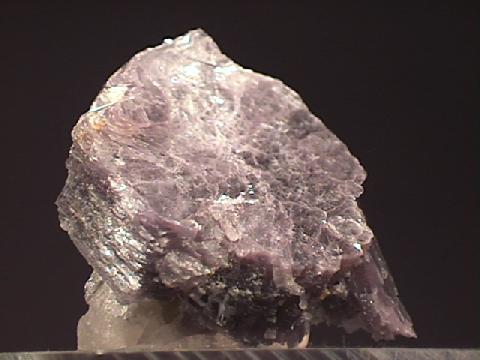
LEPIDOLITE specimen lep-3
$ 25.00
$ 25.00
Dims: 1.1 x 1.1 x 0.8" (2.8 x 2.8 x 2.0 cm)
Wt: 18.0 g w/ base
Himalaya Mine, Mesa Grande, San Diego County, California, U.S.A.
This small thumbnail speicimen confuses me a little bit. From one side, it appears to consist of a warped hexagonal tabular "book" of platelets that is partly intergrown with a smaller book. However, close examination of the opposite side of the specimen shows that this larger book is actually made up of at least 2 smaller hexagonal books, and likely more than that. This larger book has a diameter of 0.9" (2.3 cm) and a thickness of about 0.3" (8 mm), and is in very good condition, showing very little human-induced damage. Its form, though warped, is still definable- its edges are rather crooked but generally well-defined, and its faces are generally clean and possess the standard pearly, micaceous luster. All of the intergrown books have a uniform, pale lavender coloration and are generally dimly translucent under halogen light, but the largest one is still essentially opaque. There is only a small piece of broken quartz that acts as a host rock, and the specimen is hot-glued onto a square acrylic base.

lep-3 ($ 25.00)
Himalaya Mine, Mesa Grande, San Diego County, California, U.S.A.
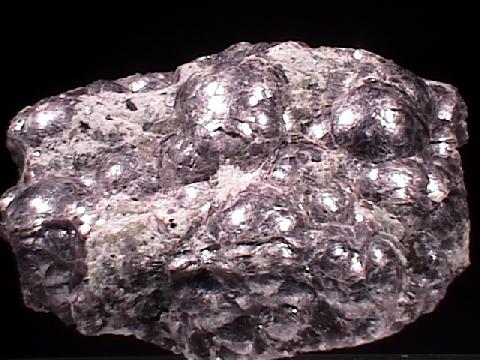
$ 80.00
Dims: 4.2 x 3.1 x 2.4" (10.7 x 7.9 x 6.1 cm)
Wt: 1 lb., 8.0 oz. (681 g)
Minas Gerais, Brazil
This hand specimen was labeled as "Botryoidal Lepidolite" when I purchased it, and that is the best way to describe it. It is made up almost entirely of Lepidolite, and though it has all of the proper characteristics, its botryoidal form is highly unusual. There is a substantial amount of damage to its outer surface, but this damage helps one to see the intense layering that one would expect of this variety of mica (see the close-up image). It has the standard gray-lavender coloration and bright, pearly luster that one expects of Lepidolite, and is suffused with a considerable amount of albite. Basically, it is just like Lepidolite in every way except for its bizarre form.
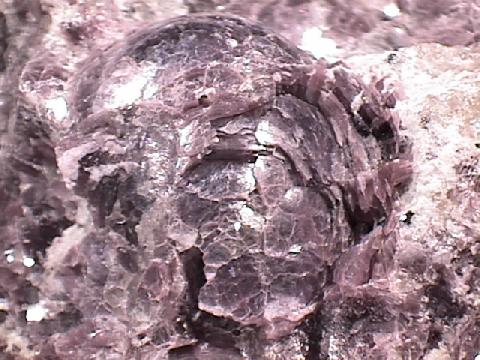

Minas Gerais, Brazil
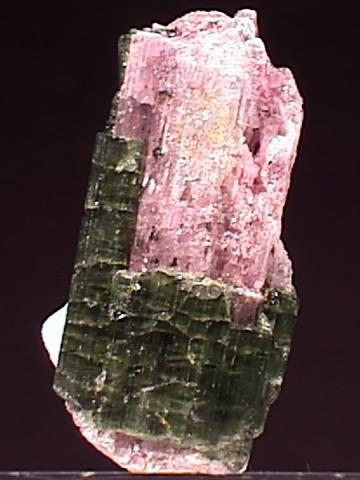
LEPIDOLITE specimen lep-5
$ 35.00
$ 35.00
Dims: 1.8 x 1.0 x 0.8" (4.6 x 2.5 x 2.0 cm)
Wt: 1.20 oz. (34.0 g)
Jacare Mine (Maloca), Itinga, Minas Gerais, Brazil
This rather odd specimen consists of a section of a classic watermelon tourmaline crystal whose rubellite core has been mostly replaced with Lepidolite. The lepidolite retains its pale gray-pink coloration, pearly luster, and micaceous, flaky consistency, but has taken on the trigonal prismatic form of the tourmaline. There is much damage to the piece, though it is difficult to separate damage done after mining to that which occurred before. A substantial portion of the green tourmaline "skin" is still present, as well as a small amount of the original rubellite core material. A small spray of broken albite blades is attached, but there is no other base or host rock present.

lep-5 ($ 35.00)
Jacare Mine (Maloca), Itinga, Minas Gerais, Brazil
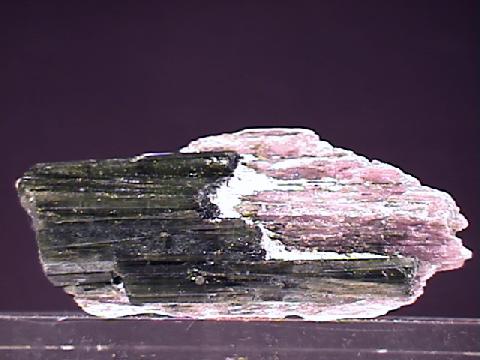
LEPIDOLITE specimen lep-6
$ 25.00
$ 25.00
Dims: 2.2 x 1.0 x 0.8" (5.6 x 2.5 x 2.0 cm))
Wt: 1.47 oz. (41.9 g)
Jacare Mine (Maloca), Itinga, Minas Gerais, Brazil
This specimen consists of what appears to be a mass of Lepidolite that is intergrown with a dark green elbaite crystal. However, examination will reveal that the Lepidolite actually replaced the pink elbaite that made up the core of the green crystal, and the surrounding Lepidolite replaced similar material. Though it is damaged and weathered, one can see a definite hexagonal cross-section to the Lepidolite. It has the classic pink color, pearly luster, and micaceous tendencies of its species. It seems, however, that it did not completely replace the tourmaline, as another, fibrous mineral is present. I cannot identify this mineral, but it consists of small, very thin fibers that rest on and within hollows in the Lepidolite. It could be more elbaite, but I do not personally think so. There is no host rock present.

lep-6 ($ 25.00)
Jacare Mine (Maloca), Itinga, Minas Gerais, Brazil
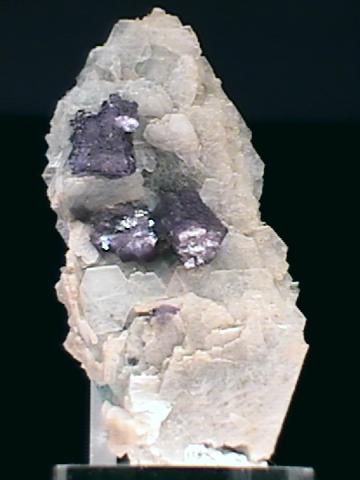
LEPIDOLITE specimen lep-7
$ 110.00
$ 110.00
Dims: 3.4 x 1.8 x 1.0" (8.6 x 4.6 x 2.5 cm)
Wt: 3.12 oz. (88.5 g) w/ base
Otjua Mine, Karibib, Namibia
Four Lepidolite "books" rest in the crystalline albite host of this specimen. The largest of these books has visible dimensions of 0.5 x 0.4 x 0.4" (1.3 x 1.0 x 1.0 cm), and all are in excellent condition, showing no obvious damage. These "books" take on a nearly crystalline form themselves, as they have hexagonal or trigonal cross-sections and each of their "prism" faces are made up of complex crystalline formations that look like smaller, partly intergrown crystals. They have the obvious basal cleavage of all micas, and show a bright pearly luster on these exposed faces, whereas the other "prism" faces have a dull waxy luster. All have the classic violet coloration of Lepidolite, though the color of these books is a bit deeper than that of most that I have seen. They are dimly translucent under normal light. The albite in which they are embedded is of the variety known as cleavelandite and consists of many intergrown, pseudohexagonal blades that are generally in good condition. The piece is affixed to a makeshift acrylic base with a removable putty.
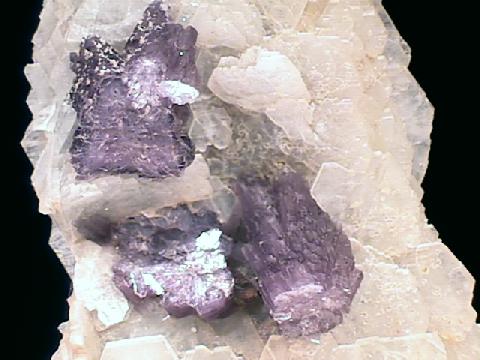

lep-7 ($110.00)
Otjua Mine, Karibib, Namibia